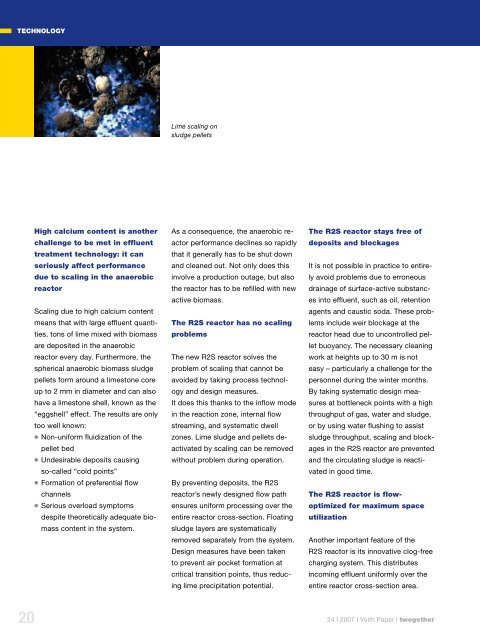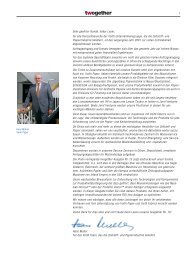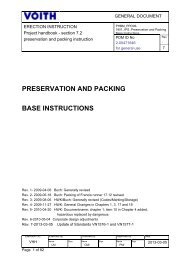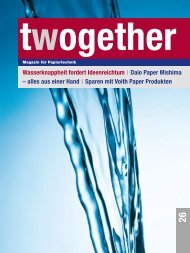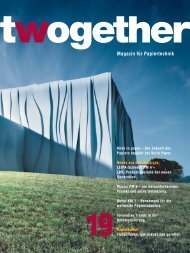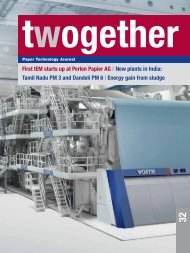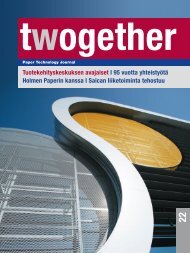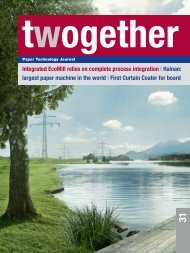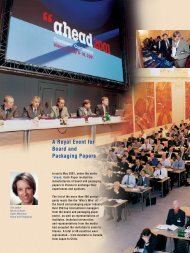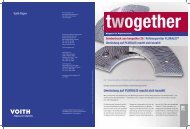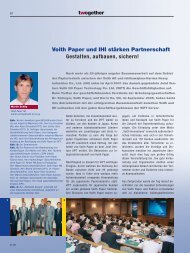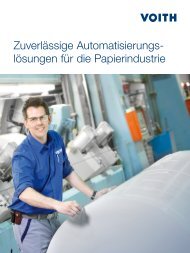ATMOS Premium Tissue I Energy efficiency â A challenge for ... - Voith
ATMOS Premium Tissue I Energy efficiency â A challenge for ... - Voith
ATMOS Premium Tissue I Energy efficiency â A challenge for ... - Voith
Create successful ePaper yourself
Turn your PDF publications into a flip-book with our unique Google optimized e-Paper software.
Technology<br />
20<br />
high calcium content is another<br />
<strong>challenge</strong> to be met in effluent<br />
treatment technology: it can<br />
seriously affect per<strong>for</strong>mance<br />
due to scaling in the anaerobic<br />
reactor<br />
Scaling due to high calcium content<br />
means that with large effluent quantities,<br />
tons of lime mixed with biomass<br />
are deposited in the anaerobic<br />
reactor every day. Furthermore, the<br />
spherical anaerobic biomass sludge<br />
pellets <strong>for</strong>m around a limestone core<br />
up to 2 mm in diameter and can also<br />
have a limestone shell, known as the<br />
“eggshell” effect. The results are only<br />
too well known:<br />
c Non-uni<strong>for</strong>m fluidization of the<br />
pellet bed<br />
c Undesirable deposits causing<br />
so-called “cold points”<br />
c Formation of preferential flow<br />
channels<br />
c Serious overload symptoms<br />
despite theoretically adequate biomass<br />
content in the system.<br />
Lime scaling on<br />
sludge pellets<br />
As a consequence, the anaerobic reactor<br />
per<strong>for</strong>mance declines so rapidly<br />
that it generally has to be shut down<br />
and cleaned out. Not only does this<br />
involve a production outage, but also<br />
the reactor has to be refilled with new<br />
active biomass.<br />
The R2S reactor has no scaling<br />
problems<br />
The new R2S reactor solves the<br />
problem of scaling that cannot be<br />
avoided by taking process technology<br />
and design measures.<br />
It does this thanks to the inflow mode<br />
in the reaction zone, internal flow<br />
streaming, and systematic dwell<br />
zones. Lime sludge and pellets deactivated<br />
by scaling can be removed<br />
without problem during operation.<br />
By preventing deposits, the R2S<br />
reactor’s newly designed flow path<br />
ensures uni<strong>for</strong>m processing over the<br />
entire reactor cross-section. Floating<br />
sludge layers are systematically<br />
removed separately from the system.<br />
Design measures have been taken<br />
to prevent air pocket <strong>for</strong>mation at<br />
critical transition points, thus reducing<br />
lime precipitation potential.<br />
The R2S reactor stays free of<br />
deposits and blockages<br />
It is not possible in practice to entirely<br />
avoid problems due to erroneous<br />
drainage of surface-active substances<br />
into effluent, such as oil, retention<br />
agents and caustic soda. These problems<br />
include weir blockage at the<br />
reactor head due to uncontrolled pellet<br />
buoyancy. The necessary cleaning<br />
work at heights up to 30 m is not<br />
easy – particularly a <strong>challenge</strong> <strong>for</strong> the<br />
personnel during the winter months.<br />
By taking systematic design measures<br />
at bottleneck points with a high<br />
throughput of gas, water and sludge,<br />
or by using water flushing to assist<br />
sludge throughput, scaling and blockages<br />
in the R2S reactor are prevented<br />
and the circulating sludge is reactivated<br />
in good time.<br />
The R2S reactor is flow-<br />
optimized <strong>for</strong> maximum space<br />
utilization<br />
Another important feature of the<br />
R2S reactor is its innovative clog-free<br />
charging system. This distributes<br />
incoming effluent uni<strong>for</strong>mly over the<br />
entire reactor cross-section area.<br />
24 I 2007 I <strong>Voith</strong> Paper I twogether


